One of the best aspects of living in Victoria is that we don’t really have to travel too far to enjoy sensational fishing. All we have to do is to think of which Victorian species we want to catch and head out search for it.
However, not all anglers have boats and finding productive locations to fish from the land can at times be very time consuming and unprofitable.
While there are plenty of locations to choose where to fish, locations such as Phillip Island can offer holidaymakers and weekend anglers a huge variety of areas and diversity of species that can be caught.
Before I get right into the nitty-gritties of where to fish on the Island, the first piece of advice that I can give is for land-based angler to download the Google Earth app on their Smartphone. This will become invaluable when searching for land-based areas.
Year round, fishing the coastline of the Island is very popular and, of course, holiday season is crowded but there are still plenty of locations to escape the crowds – it all comes down to what you want to catch.
Phillip Island has three productive piers located at Cowes, Rhyll and Newhaven. Cowes and Newhaven have access to very deep water but they are also heavily affected by tide, limiting fishing time to around 2 hours either side of a tide change for best results. Calamari, snapper, gummy sharks, garfish, mullet, silver trevally, mulloway, sevengill sharks, bronze whalers and basically every Western Port fish species can be caught from both these piers.
Rhyll on the other hand is situated more on a mud flat and the tide is less of an issue so fishing time can be throughout the entire tide. Due to its location, flathead, mullet, whiting and elephants are the best targets.
If you’re looking for somewhere to be on your own or at least a less crowded location, Cape Woolamai, Berrys Beach and Kitty Miller Bay are top locations to go in search of salmon and silver trevally throughout winter. During the warmer months, Berrys Beach and Kitty Miller Bay are producers of big whiting from the rocks.
If we head around to the nobbies, There’s a small path leads down from the road to a basalt coastline known as Cowrie Beach. During August and September, garfish are the main target and some of these gritters can fetch as easy 45cm.
Those who like catching sharks, Cat Bay and Flynns Beach are two of the most popular locations. Fishing at night during a high tide is the prime time but keep an eye on the weather conditions, an easterly wind is best here.
Ventnor Beach and Cleeland Bight may not look like much but from October to March, fishing a high tide at night is very productive for calamari.
Lastly, there is also the freshwater fishing option on the Island if you’re not having any luck fishing in the salt. Rhyll is fortunate to have the Rhyll Trout and Bush Tucker Farm and if you’re a weekend dangler that has very little luck, you can always stroll on down and catch up with owner Adam for all the assistance for catching a trout.
Fishing techniques vary greatly when fishing the Island, mainly due to the vast array of species that can be caught.
Basic techniques can consists of a simple paternoster rig where by you suspend two dropper loops containing a hook each above a sinker. If you can’t tie up yourself, you can always purchase a Mustad pre-tied snapper rig. Then all you have to do is put on some bait and cast out. If you’re going to target smaller species, remove the hooks and replace with a different style and or size to suit.
If you are a self confessed fishing tragic, then targeting specific species with the right technique will yield a better result than just hoping to catch something.
Each species may have a different setup required due to where they feed in the water column and or how big their mouth is will differentiate which hook to be used.
When targeting gummy sharks from the pier or beach a running sinker rig tied from 60-80lb trace will suffice and ensure you’re using a quality hook such as Mustad’s Octopus Circle in a 5/0-6/0 size. The circle will allow a much cleaner hook set without you having to manually set it, which could result in missing the fish.
Snapper can also be taken on this rig as well as a paternoster. Paternoster rigs can be tied from 60lb with two droppers using Mustad’s Octopus Circle in a 5/0 or 6/0 size.
Smaller species such as whiting, mullet, flathead, silver trevally or salmon are very popular species for anglers when fishing from the local piers. Paternoster rigs tied from 10-15lb fluorocarbon leader is ideal as the leader is much more abrasive resistant, which you’ll require if a fish runs you around the pier pylon. Hooks in a #4 Mustad Demon light gauge, #6 Bloodworm long shank and stainless steel Mustad 92647S #2 and #1/0 will cover all species. The species being targeted will dictate which hook to be used.
Garfish on the other hand are a top and mid water feeder and have very small mouths. To catch them, use a float setup and rig it with about 4lb leader. Due to their small mouth, a hook too large will leave you empty handed but for the past 20 years, I have sworn by the Mustad 4540 1/2 model as it is an offset half gauge hook that sets much better than any other I have ever used.
When targeting garfish from any of the piers, it is best to use the Bate Mate branded tuna oil infused pollard berley. Every 5 minutes, toss in a hand full of berley, and cast your float and bait into the trail. It might take a little while but the gars will sniff out the trail soon enough.
Another hot favourite species are calamari and best of all, they can be targeted year round. Calamari can be caught from the beach or from any of the piers and are best targeted on a high tide.
Calamari can be caught from the piers using an artificial jig in either a 2.5, 3.0 or 3.5 size. You do need to get your tide timing right and fish around an hour either side of the high tide change. From a beach on the other hand, a baited jig approach is a better option. Firstly you can cast out into deeper water and because it will be suspended under a float, can cover a greater area by letting the tide carry it.
At night however, it will pay to put a glow stick into the top of the float so you can see when a calamari takes the bait and pulls the float under the water.
Of course you can have the right location, time, tide and setup but you still need the right bait to coax your desired species to the hook.
They say fresh is best, but that is if you have the time to catch it yourself. At the end of the day, as long as you have a small selection of baits available you’ll catch something worth eating.
Bait selection can be a little daunting at times as well as how to present the bait correctly for the species you’re targeting.
With the use of circle hooks today, bait presentation is much easier and you’ll actually use far less bait. For instance, when targeting snapper and gummy sharks a simple calamari ring with the hook pinned in the top is as simple as bait practices go.
For whiting, a pipi or mussel wrapped around a #6 circle hook or long shank hook with the hook point exposed. For some reason there are a select number of anglers that feel the need to try and hide hooks in the bait altogether. When placing baits on hooks always leave as much of the hooks point exposed as possible to ensure maximum hook set when a fish takes the bait.
Berleying is also equally as important as using good baits. Berley attracts the fish to your area and without it; you could be casting 1 small piece of bait into a big area that may only attract 1 fish. Personally, I’d like the whole school of fish in the area.
When fishing from a pier, fill an onion bag with fish pellets and tuna oil and hang on the surface of the water with a rope. This will send a trail of berley with the tide and thus, bring fish right to the pier.
From the beach or rocks, an onion bag can still be used and tossed out into the waves on a long rope. Obviously, this has to be secured so take a surf rod holder and stake off into the sand. With each wave or just the current pressure, the berley will draw fish towards the beach. Then, in both cases, cast your baits into the trail and wait for the fish to come.
Fishing around Phillip Island is extremely popular year round for weekend anglers and holidaymakers. Best of all, there is always something to catch, all you have to do pack your kit and make a cast.
TEXT BOX
BAIT TABLE
| Snapper | Calamari, pilchard and garfish |
|---|---|
| Gummy Shark | Calamari, Salmon fillet, silver trevally fillet and tuna |
| Elephant Fish | Pipi, pilchard and calamari |
| Whiting | Pipi and mussel |
| Salmon | Pipi, Blue bait and white bait |
| Silver trevally | Pipi |
| Calamari | Silver whiting and pilchard |
| Flathead | Anything |
YEAR ROUND OPTIONS
| Janurary | Whiting – Cleeland Bight and Ventnor Beach |
|---|---|
| Feburary | Garfish – Cowrie Beach |
| March | Land Based Elephants – Cowes Pier |
| April | Land Based Elephants – Rhyll Pier |
| May | Salmon – Cowes Pier |
| June | Salmon – Cape Woolamai |
| July | Salmon – Berrys Beach and Kitty Miller Bay |
| August | Calamari – Ventnor Beach and Cleeland Bight |
| September | Garfish – Cowrie Beach |
| October | Gummy Shark – Cat Bay |
| November | Snapper – Cat Bay and Cowes Pier |
| December | Snapper and gummy shark – Cowes Pier |
SUGGESTED TACKLE BOX
| Leader | Surecatch 12, 15, 20, 60 and 80lb |
|---|---|
| Pre-tied rigs | Icon Takeshi Bottom Dweller 4/0, 5/0 & 6/0 |
| Swivels | Mustad round rolling swivel size #1 |
| Hooks | Mustad Demon Offset Circle #5/0 & #6/0, Mustad Octopus #5/0 Mustad Bloodworm size #12, #10, #8, #6, & #1, Mustad Demon Light size #4, #6, #1, #1/0 & #3/0 |
| Sinkers | Bomb style from 1oz to 6oz, star style from 1oz to 6oz. |

When fishing the surf beaches such as Cape Woolamai, having an assortment of baits and terminal tackle can aid in success by being able to change and adapt to the species and conditions on the given day.
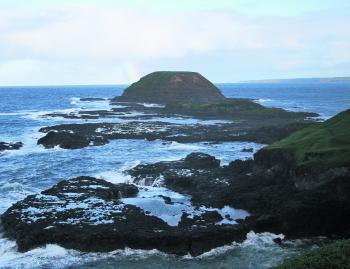
Quite dangerous locations to fish, rock ledges around Phillip Island produce, garfish, salmon, silver trevally, sweep, wrasse, snapper, calamari, whiting, snook, pike and the occasional kingfish at different times of the year.
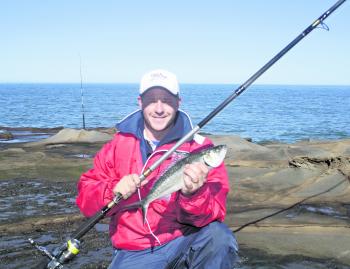
The author in his younger years thrived on spinning from the stones around the Island. Today, spinning for salmon is a popular affair at Kitty Miller Bay and Berry’s Beach in the winter months.
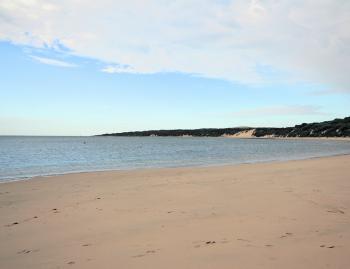
Cleeland Bight at the end of ‘the cranny’ is a secluded location that see’s very little fishing pressure. Pinkie snapper, whiting, wrasse and calamari are the common species caught year round.

All the piers around Phillip Island produce garfish. Cowes and Newhaven are the most prolific throughout late winter and spring.
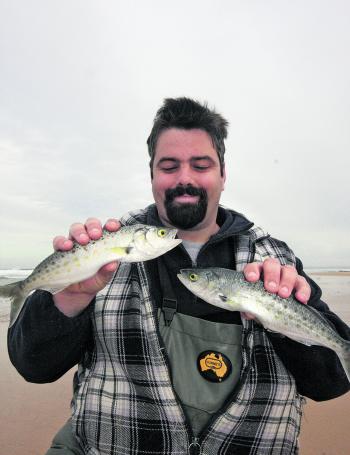
Bait fishing methods for salmon works well but spinning with small metal slugs using a single Mustad inline lure hook is much more entertaining.

The Cowes Pier is the only due north facing pier in Victoria. That aside, a simple cast can land a bait in 7m of water, where every species of fish found in Western Port can be caught at some point throughout the year.
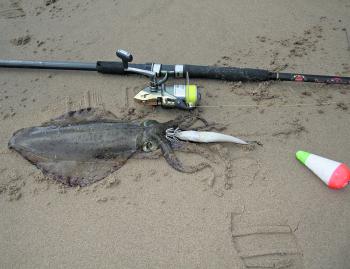
There are many weed beds within a case from the shoreline around Phillip Island. Ventnor Beach and Cleeland Bight are the most profitable throughout the summer months, and calamari like this can be caught from the sand.




